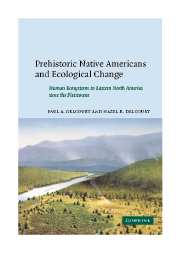 Prehistoric Native Americans and Ecological Change
Prehistoric Native Americans and Ecological Change 2 - Panarchy theory and Quaternary ecosystems
Published online by Cambridge University Press: 30 October 2009
Summary
PANARCHY THEORY
The term “panarchy” was coined as a combination of “pan,” the ancient Greek god of nature, and “hierarchy” (Holling, 2001). Panarchy theory is an extension of ecosystem theory, which rests upon the assumption that a hierarchically nested series of adaptive cycles result in self-organizing, evolving, complex natural systems that assemble across all scales in space and time. Holling (1995) defined four ecosystem functions that are interconnected by a series of flows of nutrients and energy (Figure 2.1). Ecosystem development begins with an exploitation phase during which opportunistic, pioneer species (r-strategists) dominate. During successional development, the ecosystem enters a conservation stage in which nutrients are garnered and biomass is gained, with early-successional pioneer species gradually replaced by late-successional species (K-strategists). The exploitation stage proceeds slowly to the conservation stage. Once attaining the conservation stage, ecosystems are vulnerable to more rapid changes that may be triggered by stochastic events such as fire, windstorm, or pathogen outbreaks, resulting in release of energy and nutrients (omega phase) and necessitating a major reorganization (alpha phase) during which the system can either recycle along the same loop or flip to an alternate state. This view of ecosystem development is consistent with results from long-term ecological research studies such as Hubbard Brook Watershed (Bormann and Likens, 1979). It forms an adaptive cycle that continually moves through the four phases of ecosystem growth, accumulation, restructuring, and renewal, but also is subject to evolutionary change (Holling, 2001).
- Type
- Chapter
- Information
- Prehistoric Native Americans and Ecological ChangeHuman Ecosystems in Eastern North America since the Pleistocene, pp. 11 - 17Publisher: Cambridge University PressPrint publication year: 2004


